Improving the Formation and Quality of Weld Joints on Aluminium Alloys during TIG Welding Using Flux Backing Tape
Abstract
1. Introduction
2. Materials and Methods
3. Results and Discussions
4. Conclusions
- ➢
- Flux backing tape during TIG welding allows full-penetration welds with a thickness of up to 8 mm to be achieved in a single pass without any edge preparation. The quality and mechanical properties of the welded joints were significantly enhanced. The proposed technique increases productivity and reduces the complexity of welding work, as well as economizing the use of welding materials and electricity.
- ➢
- The quality of the welded joints produced using flux backing tape is higher in comparison with those obtained using the conventional TIG process. The obtained results showed a decrease in root penetration compared with welding without flux backing tape, by several times.
- ➢
- It is established that the using flux backing tape during TIG welding on the AMg6 alloy contributes to the removal of oxide inclusions. The flux backing tape’s effectiveness is more obvious when the thickness of the flux on the backing tape is in the range of 0.3–0.4 mm.
- ➢
- The proposed variant of the TIG welding method, in comparison with the conventional TIG process, enable an increase in productivity. The flux backing tape technique reduces the complexity of welded products by two times and decreases the cost of welding materials by up to 43% and electricity consumption by up to 60%, meeting the industry’s needs.
- ➢
- The flux backing tape technique is more effective in joining aluminium alloy AMg6 plates with thicknesses of more than 4 mm in comparison with TIG welding performed with a ceramic support. A flexible tape is used together with the flux. The tape prevents the weld bead from sagging. Moreover, the flux cleans the weld metal of oxide films and removes porosity, and also protects the weld penetration from the external environment.
Author Contributions
Funding
Data Availability Statement
Conflicts of Interest
References
- Varshney, D.; Kumar, K. Application and use of different aluminium alloys with respect to workability, strength and welding parameter optimization. Ain Shams Eng. J. 2021, 12, 1143–1152. [Google Scholar] [CrossRef]
- Hajioui, E.A.; Bouchaala, K.; Faqir, M.; Essadiqi, E.A. review of manufacturing processes, mechanical properties and precipitations for aluminium lithium alloys used in aeronautic applications. Heliyon 2023, 9, e12565. [Google Scholar] [CrossRef]
- Rajesh, P.V.; Manish, K.L. A short review on aluminium alloys and welding in structural applications. Mater. Today Proc. 2021, 46, 10687–10691. [Google Scholar]
- Wahid, M.A.; Siddiquee, A.N.; Khan, Z.A. Aluminium alloys in marine construction: Characteristics, application, and problems from a fabrication viewpoint. Mar. Syst. Ocean. Technol. 2020, 15, 70–80. [Google Scholar] [CrossRef]
- Blanco, D.; Rubio, E.M.; Raquel, M.L.P.; María, A.S.N. Sustainable Processes in Aluminium, Magnesium, and Titanium Alloys Applied to the Transport Sector: A Review. Metals 2022, 12, 9. [Google Scholar] [CrossRef]
- Zhang, X.; Chen, Y.; Hu, J. Recent advances in the development of aerospace materials. Prog. Aerosp. Sci. 2018, 97, 22–34. [Google Scholar] [CrossRef]
- Gloria, A.; Montanari, R.; Richetta, M.; Varone, A. Alloys for aeronautic applications: State of the art and Perspectives. Metals 2019, 9, 662. [Google Scholar] [CrossRef]
- Janani, K.S.; Jainul, A.; Fathima, H.R.M.N.; Shaik, F.H.; Sankar, R. Recent advances in joining techniques and its parameters for aluminium alloys—Review. IJUSE 2021, 7, 1–18. [Google Scholar]
- Ma, Y.; Niu, S.; Liu, H.; Li, Y.; Ma, N. Microstructural evolution in friction self-piercing riveted aluminium alloy AA7075-T6 joints. J. Mater. Sci. Technol. 2021, 82, 80–95. [Google Scholar] [CrossRef]
- Aravind, S.; Daniel, D.A. An examination on GTAW samples of 7-series aluminium alloy using response surface methodology. Mater. Today 2020, 37, 614–620. [Google Scholar] [CrossRef]
- Li, S.; Mi, G.; Wang, C.A. study on laser beam oscillating welding characteristics for the 5083 aluminium alloy: Morphology, microstructure, and mechanical properties. J. Manuf. Process. 2020, 53, 12–20. [Google Scholar] [CrossRef]
- Wallerstein, D.; Salminen, A.; Lusquiños, F.; Comesaña, R.; Jesús, d.V.G.; Antonio, R.R.; Aida, B.; Juan, P. Recent Developments in Laser Welding of Aluminium Alloys to Steel. Metals 2021, 11, 622. [Google Scholar] [CrossRef]
- Balram, Y.; Venkat, R.G.; Vishnu, V.T. Optimization of GTAW parameters for the development of dissimilar AA5052 and AA6061 joints. Mater. Today Proc. 2021, 47, 4350–4356. [Google Scholar]
- Kumar, A.; Milton, M.S. A Comparison of welding techniques of aluminium alloys, A literature review. Int. J. Sci. Eng. Res. 2016, 2, 172–175. [Google Scholar]
- Pandya, D.; Badgujar, A.; Ghetiya, N. A novel perception toward welding of stainless steel by activated TIG welding: A review. Mater. Manuf. Process 2021, 36, 877–903. [Google Scholar] [CrossRef]
- Wang, S.J.; Shen, Z.; Li, H.; Liu, F. Effect of active metal inert gas welding on the microstructure and corrosion resistance of 6061-T6 aluminium alloy. J. Alloys Compod. 2015, 647, 548–556. [Google Scholar]
- Sathish, T.; Tharmalingam, S.V.; Mohanavel, K.S.; Ashraff, A.; Alagar, K.; Ravichandran, M.; Rajkumar, S. Weldability Investigation and Optimization of Process Variables for TIG-Welded Aluminium Alloy (AA 8006). Adv. Mater. Sci. Eng. 2021, 2816338. [Google Scholar] [CrossRef]
- Sudhanshu, R.S.; Pradeep, K. A-TIG (activated flux tungsten inert gas) welding—A review. Mater. Today Proc. 2021, 44, 808–820. [Google Scholar]
- Vysakh, K.B.; Mathiazhagan, A.; Krishna, P.S. A systematic overview on activated-Tungsten inert gas welding. Weld. Int. 2022, 36, 597–615. [Google Scholar] [CrossRef]
- Dixit, P.; Suketu, J. Techniques to weld similar and dissimilar materials by ATIG welding—An overview. Mater. Manuf. Process 2021, 36, 1–16. [Google Scholar]
- Patel, D.; Jani, S. ATIG welding: A small step towards sustainable manufacturing. Adv. Mater. Process. Technol. 2021, 7, 514–536. [Google Scholar] [CrossRef]
- Rakesh, N.; Mohan, A.; Navaf, P.; Harisankar, M.S.; Nambiar, S.J.; Harikrishnan, M.; Devadathan, J.S.; Rameshkumar, K. Effect of fluxes on weld penetration during TIG welding—A review. Mater. Today. Proc. 2023, 72, 3040–3048. [Google Scholar] [CrossRef]
- Patel, N.P.; Sharma, D.K.; Upadhyay, G.H. Effect of Activated Fluxes on Weld Penetration and Mechanism Responsible for Deeper Penetration of Stainless Steels—A Review. In Current Advances in Mechanical Engineering; Lecture Notes in Mechanical Engineering; Springer: Singapore, 2021; pp. 737–746. [Google Scholar] [CrossRef]
- Vidyarthy, R.S.; Sivateja, P. Influence of activating flux tungsten inert gas welding on mechanical and metallurgical properties of the mild steel. Mater. Today Proc. 2020, 28, 977–981. [Google Scholar] [CrossRef]
- Ahmadi, E.; Ebrahimi, A.R.; Hoseinzadeh, A. Microstructure Evolution and Mechanical Properties of 2219 Aluminum Alloy A–TIG Welds. Phys. Met. Metallogr. 2020, 121, 483–488. [Google Scholar] [CrossRef]
- Baghel, A.; Sharma, C.; Rathee, S.; Srivastava, M. Activated flux TIG welding of dissimilar SS202 and SS304 alloys: Effect of oxide and chloride fluxes on microstructure and mechanical properties of joints. Mater. Today Proc. 2021, 47, 7189–7195. [Google Scholar] [CrossRef]
- Saidov, R.M.; Rakhimova, F.M.; Kusch, M.; Mayr, P.; Hoefer, K. Investigation of the peculiarities of formation of weld beads of high resistant steels during A-TIG welding. Part 1: Influence of the surface conditions of welded plates on the formation of weld beads during the TIG and A-TIG welding. Weld. Cut. 2022, 2, 114–118. [Google Scholar] [CrossRef]
- Bhanu, V.; Gupta, A.; Pandey, C. Role of A-TIG process in joining of martensitic and austenitic steels for ultra-supercritical power plants—A state of the art review. Nucl. Eng. Technol. 2022, 54, 2755–2770. [Google Scholar] [CrossRef]
- Atul, B.; Kumar, A.; Jain, V.; Gupta, D. Enhancement of activated tungsten inert gas (A-TIG) welding using multi-component TiO2-SiO2-Al2O3 hybrid flux. Measurement 2019, 148, 106912. [Google Scholar]
- Touileb, K.; Abdelil, C.H.; Rachid, D.; Abousoufiane, O.; Abdallah, B.; Albaijan, I.; Hany, S.A.; Mohamed, M.Z.A. Mechanical, Microstructure, and Corrosion Characterization of Dissimilar Austenitic 316L and Duplex 2205 Stainless-Steel, ATIG Welded Joints. Materials 2022, 15, 2470. [Google Scholar] [CrossRef]
- Suman, S.; Santanu, D. Effect of Polarity and Oxide Fluxes on Weld-bead Geometry in Activated Tungsten Inert Gas (A-TIG) Welding. J. Weld. Join. 2020, 38, 380–388. [Google Scholar]
- Singh, R.S.; Khanna, P. Investigation of A-TIG welded duplex stainless-steel plates. Int. J. Interact. Des. Manuf. 2022. [Google Scholar] [CrossRef]
- Simonik, A.G. The effect of contraction of the arc discharge upon the introduction of electro-negative elements. Weld. Prod. 1976, 3, 49–51. [Google Scholar]
- Kulkarni, A.; Dwivedi, D.K.; Vasudevan, M. Effect of oxide fluxes on activated TIG welding of AISI 316L austenitic stainless steel. Mater. Today Proc. 2019, 18, 4695–4702. [Google Scholar] [CrossRef]
- Pandya, D.; Badgujar, A.; Ghetiya, N. Characterization and optimization of duplex stainless steel welded by activated tungsten inert gas welding process. Int. J. Interact. Des. Manuf. 2022, 1–13. [Google Scholar] [CrossRef]
- ASTM B928; Standard Specification for High Magnesium Aluminum-Alloy Sheet and Plate for Marine Service—Section 2: Standard Quality Requirements; American Standards for Testing Materials. ASTM International: West Conshohocken, PA, USA, 2023.
- Howse, D.S.; Lucas, W. Investigation into arc construction by active flux for TIG welding. Sci. Technol. Weld. Join. 2000, 5, 189–193. [Google Scholar] [CrossRef]
- Tanaka, M.; Shimizu, T.; Terasaki, H.; Ushio, M.; Koshiishi, F.; Yang, C.L. Effects of activating flux on arc phenomena in gas tungsten arc welding. Sci. Technol. Weld. Join. 2000, 6, 397–402. [Google Scholar] [CrossRef]
- Li, Q.M.; Wang, X.H.; Zou, Z.D.; Jun, W.U. Effect of activating flux on arc shape and arc voltage in tungsten inert gas welding. Trans. Nonferrous Met. Soc. China 2007, 17, 486–490. [Google Scholar] [CrossRef]
- Saidov, R.M.; Kusch, M.; Mayr, P.; Hoefer, K.; Komilova, D.R. Role of flux oxide slags in the mechanism of the formation of weld beads during the A-TIG welding of stainless steels. Weld. Cut. 2019, 6, 450–456. [Google Scholar]
- Picu, R.C.; Vincze, G.; Ozturk, F.; Gracio, J.J.; Barlat, F.; Maniatty, A.M. Strain rate sensitivity of the commercial aluminium alloy AA5182-O. Mater. Sci. Eng. A 2005, 390, 334–343. [Google Scholar] [CrossRef]
- Sielski, R.A. SSC-452 Aluminium Structure Design and Fabrication Guide; Ship Structure Committee: Washington, DC, USA, 2007. [Google Scholar]
- Sensharma, P.; Collette, M.; Harrington, J. SSC-4 Effect of Welded Properties on Aluminium Structures; Ship Structure Committee: Washington, DC, USA, 2010. [Google Scholar]
- Olugbade, T.O.; Omiyale, B.O.; Ojo, O.T.; Adeyeri, M.K. Stress-Corrosion and Corrosion-Fatigue Properties of Surface-Treated Aluminium Alloys for Structural Applications. Chem. Afr. 2023, 6, 1699–1708. [Google Scholar] [CrossRef]
- Xu, W.; Xin, Y.C.; Zhang, B.; Li, X.Y. Stress corrosion cracking resistant nanostructured Al-Mg alloy with low angle grain boundaries. Acta. Mater. A 2022, 225, 117607. [Google Scholar] [CrossRef]
- Chen, F.; Zhang, H.; Li, Z.; Luo, Y.; Xiao, X.; Liu, Y. Residual stresses effects on fatigue crack growth behavior of rib-to-deck double-sided welded joints in orthotropic steel decks. Adv. Struct. Eng. 2024, 27, 35–50. [Google Scholar] [CrossRef]
- OST 5.9153-84; Industry Standard; Welded Joints of Hull Structures. Arc Welding of Aluminium Alloys in Shielding Gases. Ministry of Water Transport: Moscow, USSR, 1984.
- Abralov, M.A.; Abdurakhmanov, P.U.; Saidov, R.M. Flux Paste for Arc Welding Aluminium Alloys, USSR. 1310156A1.30-4-1987, 15 May 1987. [Google Scholar]
- Saidov, R.M.; Kasimova, S.S.; Ischakov, A.I. A new effective method of aluminium alloys welding in shipbuilding. In Proceedings of the International Conference on Materials in Oceanic Environment, EUROMAT’98, Lisbon, Portugal, 22–24 July 1998. [Google Scholar]
- Singh, A.K.; Dey, V.; Rai, R.N. Techniques to improve weld penetration in TIG welding (A review). Mater. Today Proc. 2017, 4, 1252–1259. [Google Scholar] [CrossRef]
- Singh, A.K.; Dey, V.; Kumar, P. Use of backing mediums increase penetration during TIG welding of P91 steel. Sådhanå 2021, 46, 203. [Google Scholar] [CrossRef]
- GOST 14838-78; Wire of Aluminium and Aluminium Alloys for Cold Upsetting. Specifications. Russian National Standards: Moscow, USSR, 1978.
- ASTM E8-04; Standard Test Methods for Tension Testing of Metallic Materials, American Standards for Testing Materials. ASTM International: West Conshohocken, PA, USA, 2010.
- ASTM E190-14; Standard Test Method for Guided Bend Test for Ductility of Welds, American Standards for Testing Materials. ASTM International: West Conshohocken, PA, USA, 2021.
- ASTM E155-20; Standard Reference Radiographs for Inspection of Aluminum and Magnesium Castings, American Standards for Testing Materials. ASTM International: West Conshohocken, PA, USA, 2020.

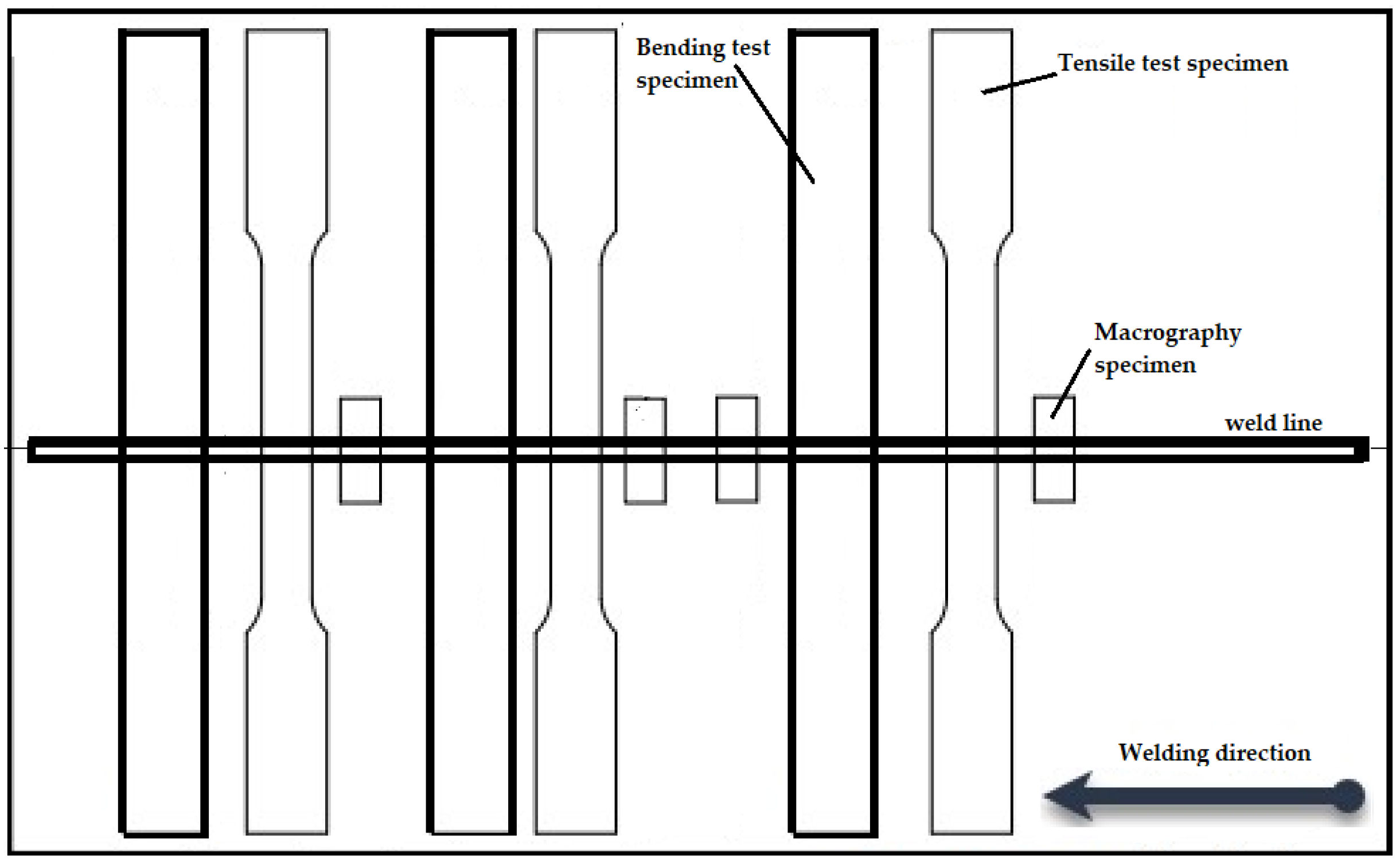
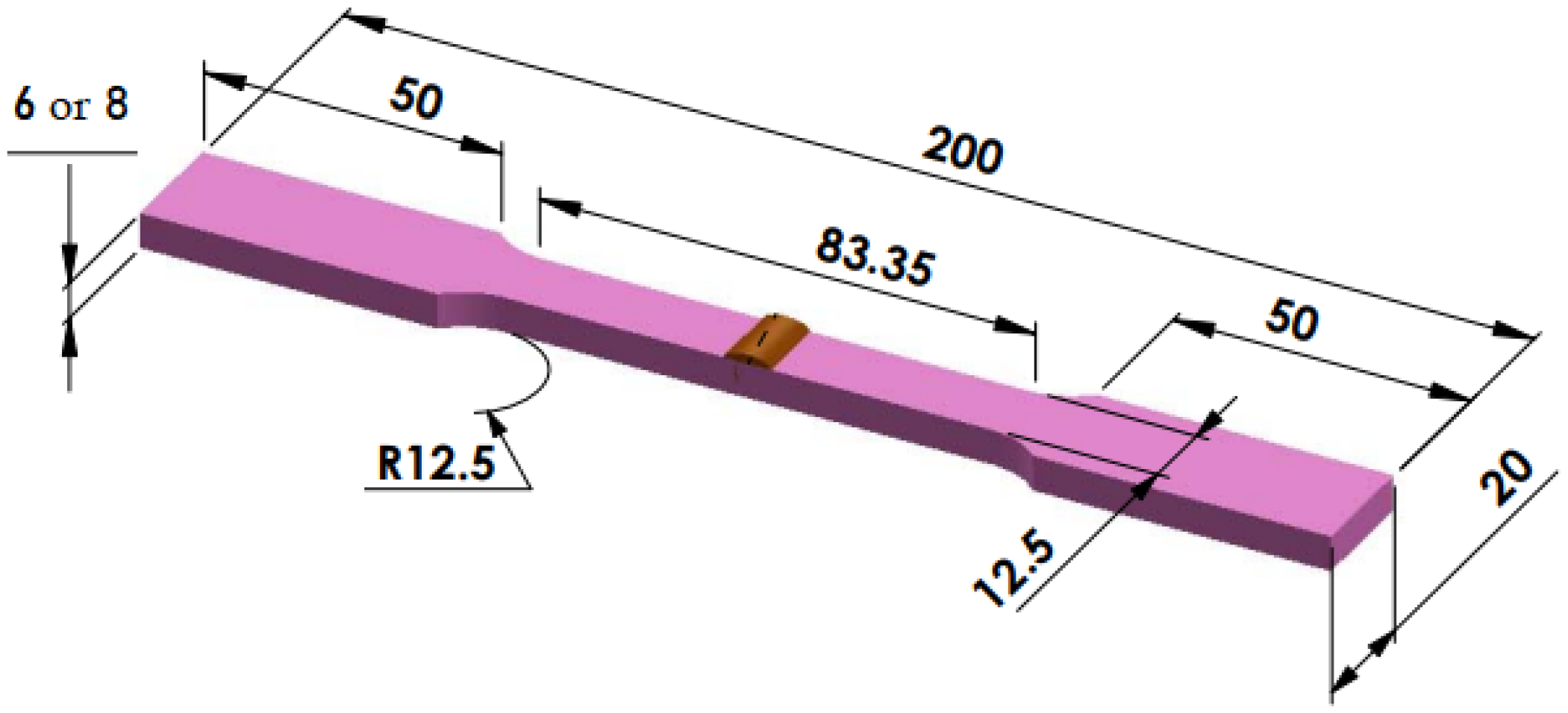

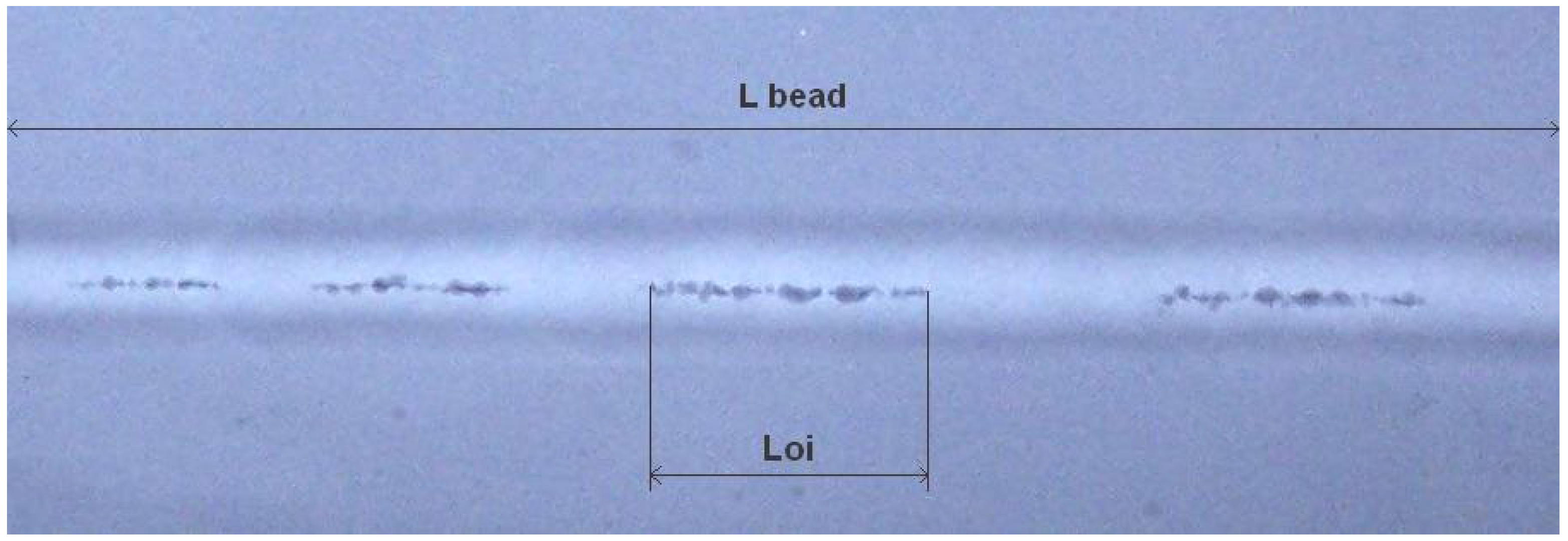
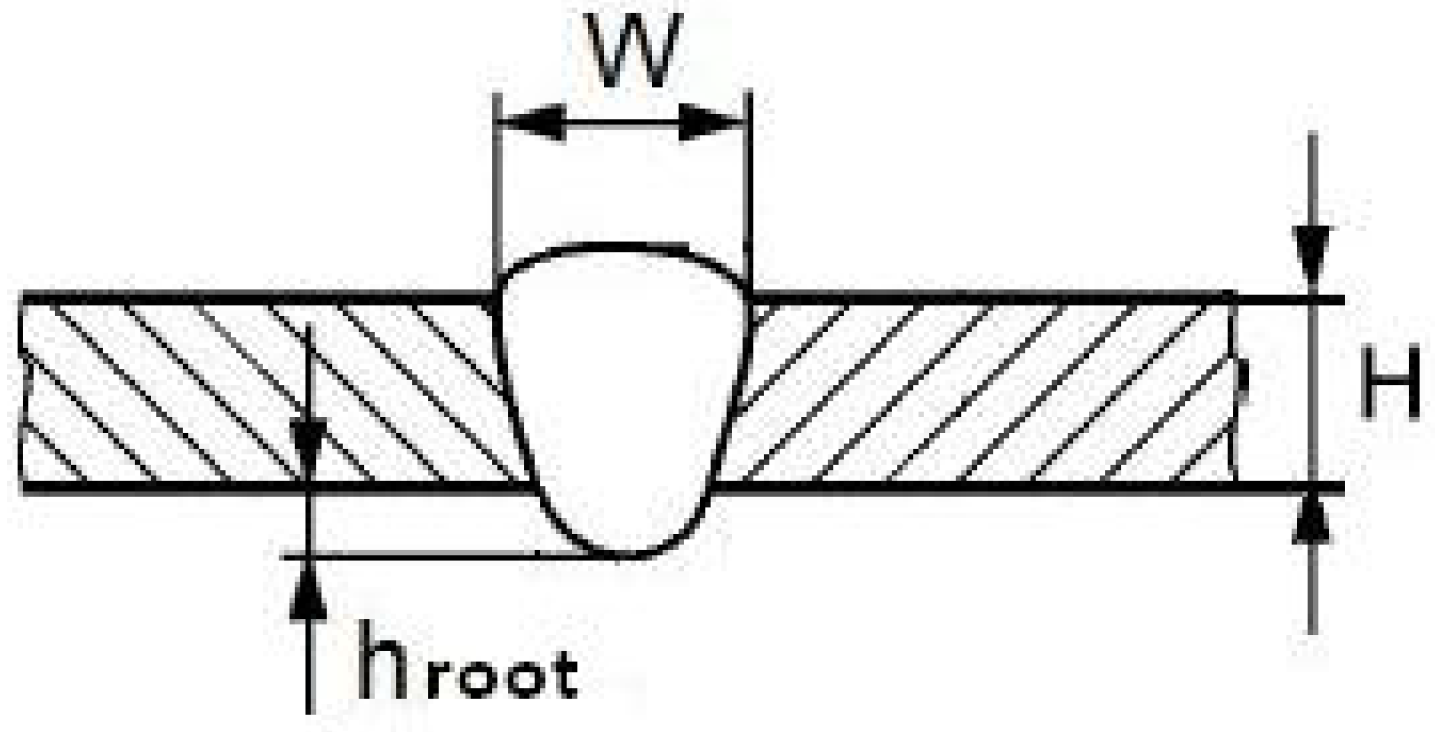

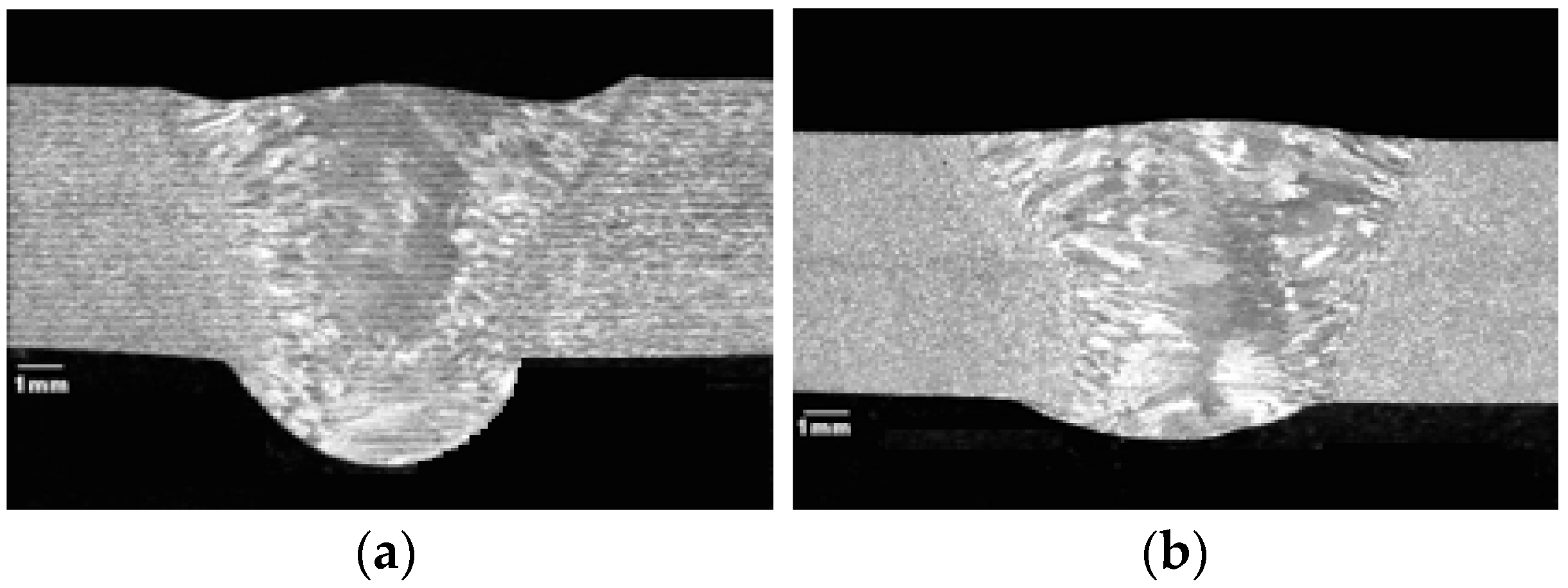

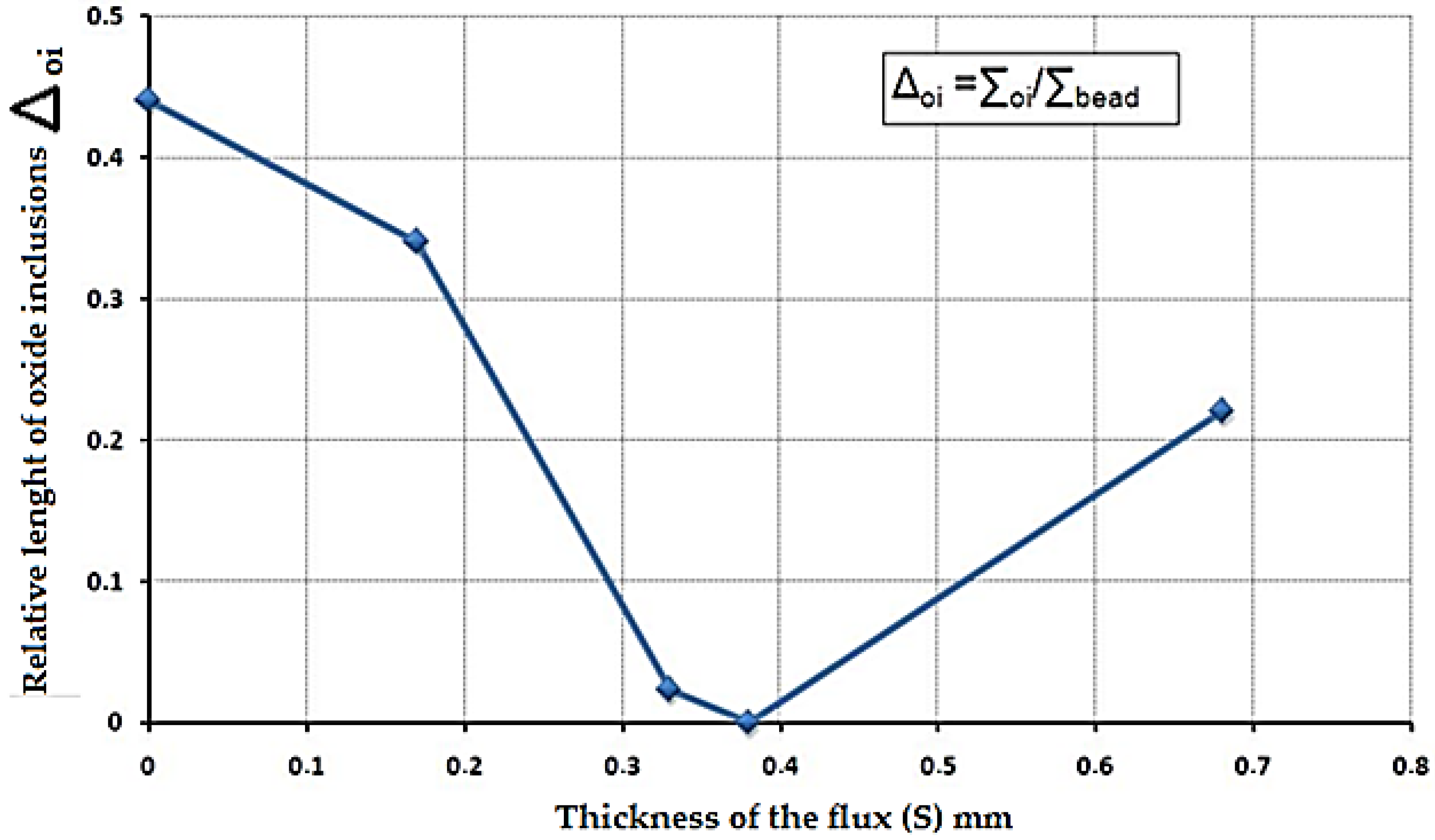
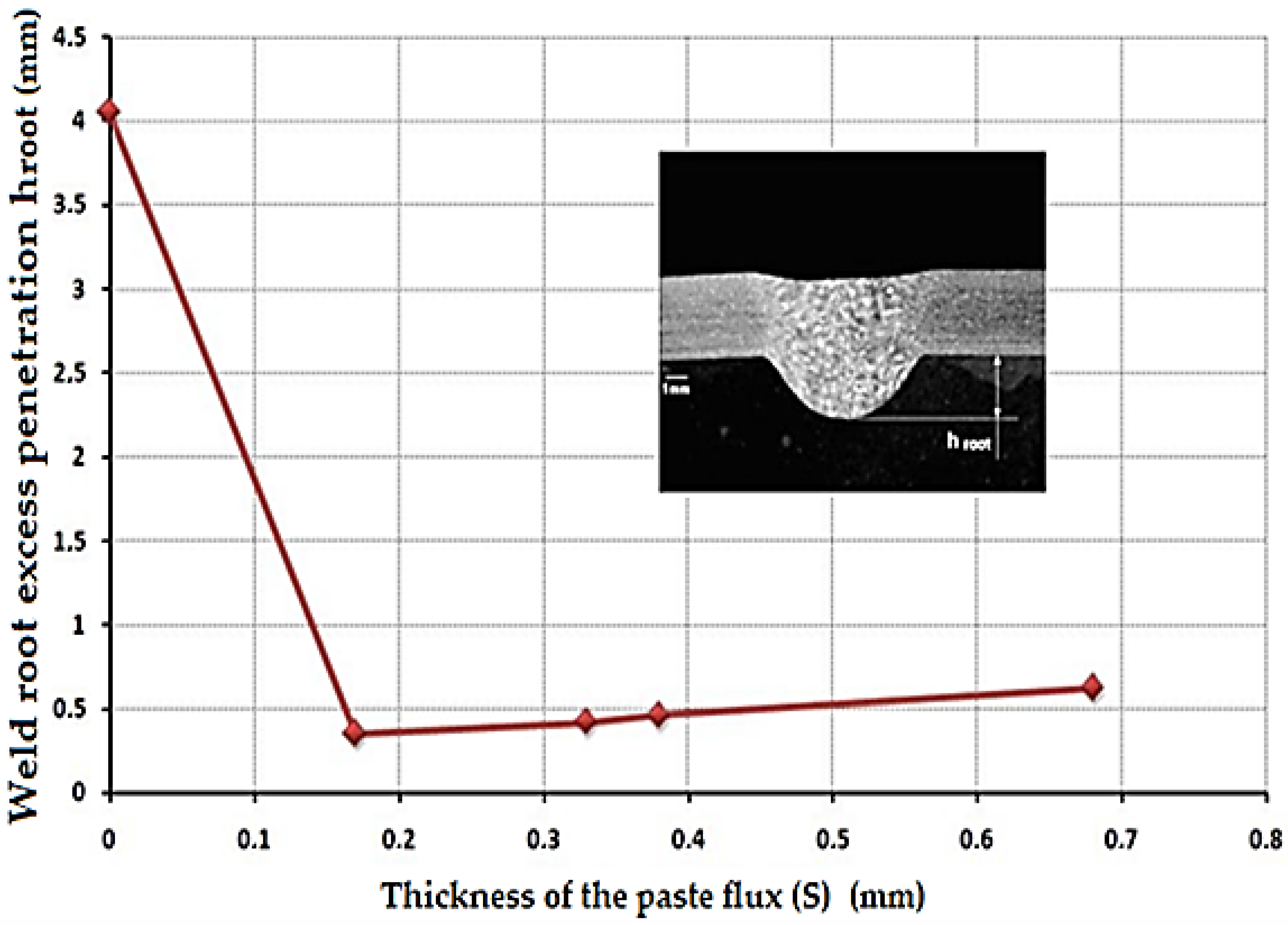
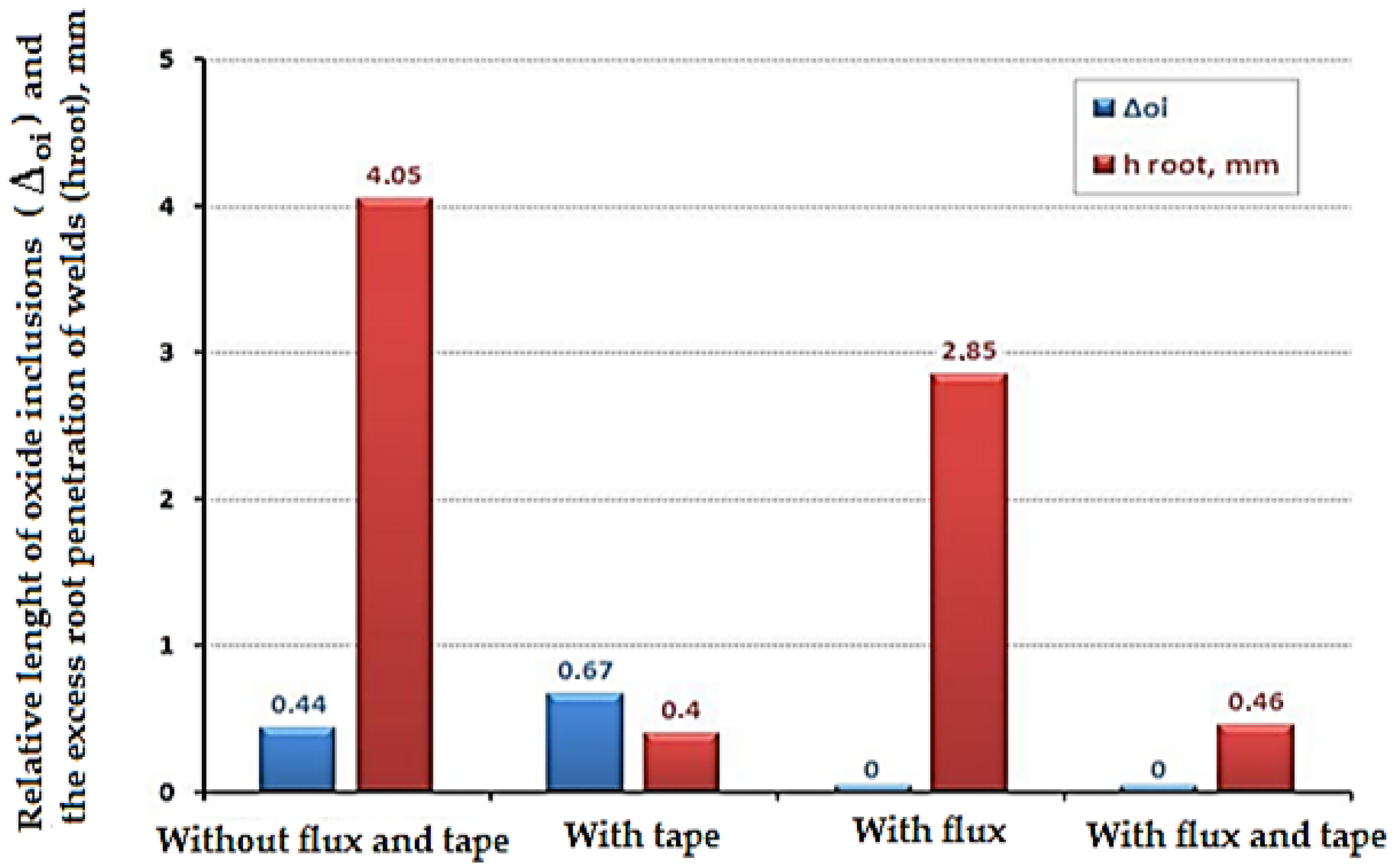
| Alloy | Cu | Mg | Mn | Zn | Fe | Si | Ti | Be |
|---|---|---|---|---|---|---|---|---|
| AMg6 | 0.1 | 5.8–6.8 | 0.5–0.8 | 0.2 | 0.4 | 0.4 | 0.02–0.1 | 0.0002–0.005 |
| Elements | Mg | Mn | Zr | Ti | Al |
|---|---|---|---|---|---|
| Weight % | 5.50–6.20 | 0.80–0.90 | 0.08–0.12 | 0.02–0.2 | balance |
| Thickness (mm) | Welding Pass | Welding Currents (A) | Arc Voltage (V) | Welding Speed (cm/min) | Feed Wire Speed (cm/min) | Shielding Gas Rate (L/min) | Heat Input (kJ/cm) |
|---|---|---|---|---|---|---|---|
| 6.0 | First | 140–150 | 11–12 | 25 | - | 8–10 | 3.960–4.032 |
| Second | 220–230 | 16–17 | 25 | 110–120 | 9–11 | 8.832–8.976 | |
| 8.0 | First | 160–170 | 13–14 | 25 | - | 8–10 | 5.304–5.376 |
| Second | 260–270 | 18–19 | 25 | 110–120 | 9–11 | 11.664–11.856 |
| Thickness (mm) | Welding Currents (A) | Arc Voltage (V) | Welding Speed (cm/min) | Feed Wire Speed (cm/min) | Shielding Gas Rate (L/min) | Heat Input (kJ/cm) |
|---|---|---|---|---|---|---|
| 6.0 | 270–280 | 19–20 | 25 | 70–80 | 9–11 | 12.768–12.960 |
| 8.0 | 320–330 | 21–22 | 25 | 70–80 | 10–12 | 16.632–16.896 |
| Thickness (mm) | Welding Method | Preparation of the Welding Edges | Weld Tensile Strength σB, MPa | σB/σBm Ratio | Bending Angle, ° |
|---|---|---|---|---|---|
| 6.0 | With backing tape | Without edge preparation | 179 | 0.6 | 50 |
| With flux backing tape | 271 | 0.91 | 82 | ||
| With backing tape | With Y-groove edge preparation | 225 | 0.75 | 101 | |
| With flux backing tape | 236 | 0.79 | 97 | ||
| 8.0 | With backing tape | Without edge preparation | 178 | 0.56 | 89 |
| With flux backing tape | 265 | 0.84 | 83 | ||
| With backing tape | With Y-groove edge preparation | 233 | 0.74 | - | |
| With flux backing tape | 236 | 0.75 | - |
Disclaimer/Publisher’s Note: The statements, opinions and data contained in all publications are solely those of the individual author(s) and contributor(s) and not of MDPI and/or the editor(s). MDPI and/or the editor(s) disclaim responsibility for any injury to people or property resulting from any ideas, methods, instructions or products referred to in the content. |
© 2024 by the authors. Licensee MDPI, Basel, Switzerland. This article is an open access article distributed under the terms and conditions of the Creative Commons Attribution (CC BY) license (https://creativecommons.org/licenses/by/4.0/).
Share and Cite
Mannapovich, S.R.; Touileb, K. Improving the Formation and Quality of Weld Joints on Aluminium Alloys during TIG Welding Using Flux Backing Tape. Metals 2024, 14, 321. https://doi.org/10.3390/met14030321
Mannapovich SR, Touileb K. Improving the Formation and Quality of Weld Joints on Aluminium Alloys during TIG Welding Using Flux Backing Tape. Metals. 2024; 14(3):321. https://doi.org/10.3390/met14030321
Chicago/Turabian StyleMannapovich, Saidov Rustam, and Kamel Touileb. 2024. "Improving the Formation and Quality of Weld Joints on Aluminium Alloys during TIG Welding Using Flux Backing Tape" Metals 14, no. 3: 321. https://doi.org/10.3390/met14030321
APA StyleMannapovich, S. R., & Touileb, K. (2024). Improving the Formation and Quality of Weld Joints on Aluminium Alloys during TIG Welding Using Flux Backing Tape. Metals, 14(3), 321. https://doi.org/10.3390/met14030321








